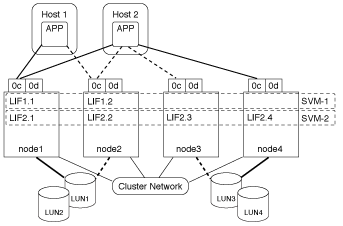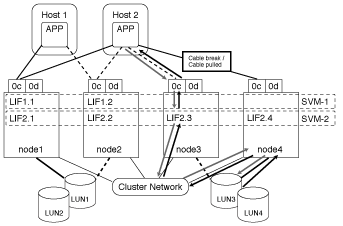How LUN access works in a virtualized environment
 Suggest changes
Suggest changes


In a virtualized environment, LIFs enable hosts (clients) to access LUNs through optimized and unoptimized paths.
A LIF is a logical interface that connects the SVM to a physical port. Although multiple SVMs can have multiple LIFs on the same port, a LIF belongs to one SVM. You can access LUNs through the SVMs LIFs.
In the following example, Host 1 connects to LIF1.1 and LIF1.2 in SVM-1 to access LUN1. LIF1.1 uses the physical port node1:0c and LIF1.2 uses the node2:0c. LIF1.1 and LIF1.2 belongs only to SVM-1. If a new LUN is created on node 1 or node 2, for SVM-1, then it can use these same LIFs. If a new SVM is created, then new LIFs can be created using physical ports 0c or 0d on both the nodes.

A physical port can support multiple LIFs serving different SVMs. Because LIFs are associated with a particular SVM, the cluster nodes can send the incoming data traffic to the correct SVM. In the following example, each node from 1 through 4 has a LIF for SVM-2 using the physical port 0c on each node. Host 1 connects to LIF1.1 and LIF1.2 in SVM-1 to access LUN1. Host 2 connects to LIF2-1 and LIF2-2 in SVM-2 to access LUN2. Both SVMs are sharing the physical port 0c on the nodes 1 and 2. SVM-2 has additional LIFs that Host 2 is using to access LUNs 3 and 4. These LIFs are using physical port 0c on nodes 3 and 4. Multiple SVMs can share the physical ports on the nodes.

In an active or optimized path, the data traffic does not travel over the cluster network; it travels the most direct route to the LUN. The active or optimized path to LUN1 is through LIF1.1 in node1, using physical port 0c. Host 2 has two active or optimized paths, one path to node1, LIF2.1, which is sharing physical port 0c and the other path to node4, LIF2.4, which is using physical port 0c.

In an active or unoptimized path (indirect) path, the data traffic travels over the cluster network. This issue occurs only if all the active or optimized paths from a host are unavailable to handle traffic. If the path from Host 2 to SVM-2 LIF2.4 is lost, then access to LUN3 and LUN4 traverses the cluster network. Access from Host 2 uses LIF2.3 on node3. Then the traffic enters the cluster network switch and backs up to node4 for access to the LUN3 and LUN4. It will then traverse back over the cluster network switch and then back out through LIF2.3 to Host 2. This active or unoptimized path is used until the path to LIF2.4 is restored or a new LIF is established for SVM-2 on another physical port on node 4.



